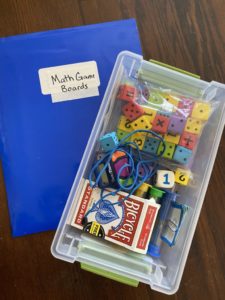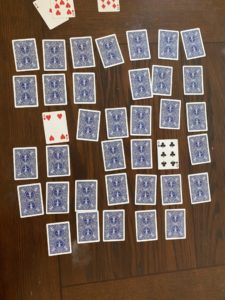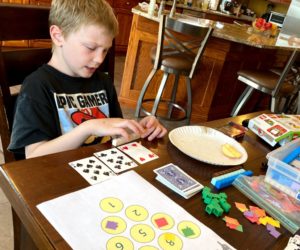 Keeping a small math game bin is so helpful for quick, not planned, fun math practice. In my bin, I keep multiple dice (some with dots, some with numbers, and even a few with math operations on them), a deck of cards with all the face cards pulled out (keep the aces in for 1’s), timers, and a stopwatch. I also have a folder stored with it to keep printed math game boards, like the one you can get below for “Math Bowling.” It doesn’t take up much space and it contains all I need for many, many math games.
Keeping a small math game bin is so helpful for quick, not planned, fun math practice. In my bin, I keep multiple dice (some with dots, some with numbers, and even a few with math operations on them), a deck of cards with all the face cards pulled out (keep the aces in for 1’s), timers, and a stopwatch. I also have a folder stored with it to keep printed math game boards, like the one you can get below for “Math Bowling.” It doesn’t take up much space and it contains all I need for many, many math games.
My oh-so-fancy Math Game Box. One box, many games.
Here are some of our favorite (and easiest) games to sharpen those addition and subtraction skills!
Tens
Skills:
Addition, Sums of Ten, memory
Supplies:
Deck of cards (numbers 1-10 only)
Play Time:
10 minutes
Number of players:
2-4
This is a mathematical twist on the old favorite game of Memory.
Instructions:
- Place all the number cards face down on the table in an array.
- The first player picks two cards, if they add to 10, keep them and go again. if they do NOT add up to 10, flip the cards back over and the turn ends.
- The next player picks two cards, keeping if they add to 10 and flipping back over if they do not.
- If a player flips over a 10 card, they keep it (the single card), and get another turn.
- Once all the cards are collected, the player with the most wins!
This game is always a quick and fun way to refresh those tens sums. It is requested often when I declare “Math Game Time!”
Math Bowling
Skills:
Addition, Subtraction, problem solving
Supplies:
Deck of cards (numbers 1-10 only) OR 3 dice
Math Bowling (print or make) with score sheet
Play Time:
20+ minutes (depending on how many players)
Number of players:
2-5
This is a mathematical twist on bowling. Well, bowling has math. This is just bowling without the fun part of hurling a ball down the alley…but I can’t install a bowling alley.
Instructions:
- Set up the game by shuffling deck and placing deck face-down (if using cards). Write names on the score card. Set out game board or sheet of paper with the numbers 1-10 to represent the 10 pins.
- Fight about who goes first. (no? Just my house?)
- First player draws three cards (or rolls three dice). With those three numbers, they try to cover or “knock down” as many numbers pins as possible using addition and subtraction. EX: if you draw 1, 5, and 7, you would cover pins 1, 5, 7, AND 4 (5-1=4), 6 (5+1=6), 2 (7-5=2), and 8 (7+1=8). This player would cover pins 1, 5, 7, 4, 6, 2, 8 and record 7 for their first roll/draw. Since they didn’t knock out all the pins, they have one more roll. Draw three new cards (or roll three dice) and try to cover the remaining numbers.
- If all ten pins are knocked out on the first draw, it’s a strike and you get 20 bonus on that turn (10 for the pins +20 bonus). The turn ends after a strike.
- If all pins are knocked down in the second draw/roll, it is a spare and you get 10 bonus points (10 for the pins and 10 bonus, 20 total for that frame)
- If not all pins are covered after the second draw, the score is simply the number of pins covered. (if they were able to cover 4 pins the first draw/roll, then 2 more on the second draw/roll, their score for that frame would be 6)
- After 10 frames, the player with the highest score wins.
Like anything else in gaming life, adjust as needed for the levels of your kids. I don’t help my oldest son find sums and sometimes he misses some, but I do offer hints to my younger son (but he has to do the math). We prefer working with cards on this game, but dice will work.
The game boards are available to download free! Enjoy!
Math War
Skills:
Addition
Suplies:
Deck of numbered cards (remove face cards, keep aces for 1’s)
Time:
15 minutes
Players:
2
This is a simple spin on the game of War. Use a numbered deck, aces are 1’s.
Simple instructions for people who know exactly how to play war:
Instead of flipping 1 card over, flip two cards over and add them. The Highest sum wins the round. If your sum matches (regardless of the numbers it took to get that sum), you have a war. Put down the standard 3 cards, then flip two and add them to see who wins. 🙂
Detailed instructions for people who don’t know the game of war:
- Shuffle the deck and deal all the cards between the two players.
- At the same time, draw two cards (instead one in regular war), add your two cards. The highest sum wins the round and collects the two cards played from the other player. Place them in a discard pile. If both players’ sums match, you have a war! (Ex: You draw 8 and 2, your opponent draws 4 and 6…you both have 10 and its a war)
- War: lay your next three cards face down (prize cards), then turn over the next two cards from your deck. The person with the highest sum wins! Winner takes all the cards from the war and places them in their discard pile.
- If your deck runs out, shuffle your discard pile and use it.
- Once a player collects all the cards in the deck, they win!
Simple instructions for people who know exactly how to play war:
Instead of flipping 1 card over, flip two cards over and add them. The Highest sum wins the round. If your sum matches (regardless of the numbers it took to get that sum), you have a war. Put down the standard 3 cards, then flip two and add them to see who wins. 🙂
So there you have it – three quick games you can whip out and get a little math practice in!



